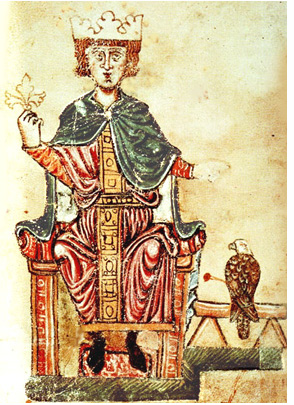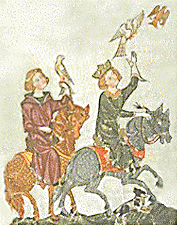...Best of Sicily presents... Best of Sicily Magazine. ... Dedicated to Sicilian art, culture, history, people, places and all things Sicilian. |
by Beniamino Inserra | |||
Magazine Index Best of Sicily Arts & Culture Fashion Food & Wine History & Society About Us Travel Faqs Contact Map of Sicily
|
Some years before the Normans conquered England, their swashbuckling brethren went south and invaded the lands of southern Italy, wresting Sicily from the resident Moors (Saracens) in a ten-year conflict beginning with the Conquest of Messina in 1061, displacing several Muslim emirs in a sort of mini-crusade. The brilliant leaders of this gang of northern knights were Robert and Roger de Hauteville. Roger's son, Roger II, was eventually crowned the first King of Sicily. King Roger proved to be an able, efficient administrator. By 1140, he was able to reorganise the government of the island, embark on an admirable building programme and encourage gifted people from different traditions and even religions to contribute their wisdom and experience to the enrichment of his court, creating a multicultural environment not unlike today's London or New York. Imitating oriental habits, Roger II gathered much power in his own hands and ruled Sicily and southern Italy as a benevolent despot in the Byzantine tradition, distinguishing his form of government from that of the Normans in England. At his death in 1154, Roger II was succeeded by his son, William I, whose policies often met with opposition from the entrenched Norman vassals. In 1166, William "the Bad" died and was succeeded by his young son William II "the Good" under a regency. In 1189, at thirty six, this sovereign died and was succeeded by his aunt, Constance, a daughter of Roger II and wife of the powerful central European ruler Henry VI of the Swabian von Hohenstaufen dynasty. After much turmoil and intrigue (provoked in part by Tancred, a bastard grandson of Roger II), Henry VI, Holy Roman Emperor and son of the great Barbarossa, was crowned King of Sicily by right of marriage at Palermo Cathedral on Christmas day 1194. In Apulia, on the mainland, the previously childless Constance gave birth, at 40 (in the presence of numerous witnesses), to a son christened Frederick Roger. Henry was not liked in Sicily, but the imperial couple had managed to
defeat their enemies and secure the support of the nobles and the Pope.
They established their rule and that of their son over the unruly but still
very wealthy Kingdom of Sicily, which encompassed all Legends abound of his childhood in Palermo, then a city of stupendous gardens and beautiful Norman-Arab architecture. He learned social survival but also respect for various peoples and religions (Christian, Muslim, Jewish), acquiring a good knowledge of Arabic, Greek, Latin, Italian, Sicilian, German and Norman French. In Palermo, the stories tell us, Frederick could listen and learn from returning sailors and merchants of exotic foreign lands and customs to the south and east. He could learn from scholars, philosophers, historians, artisans, chroniclers, astrologers and animal trainers (there was a large zoo of "foreign" beasts), and he cultivated a passion for falconry, about which he wrote a guide. In 1209, at the age of 15, he married Constance of Aragon, who was many years his senior. In fact, she often served as his "regent" or "viceroy" during his long absences from Sicily. Frederick's long reign took him into the heart of Germany to tame his rebellious vassals, and to the Holy Land on crusade. The details of the international intrigue and conflicts that engulfed Western Europe and Frederick II in the early decades of the thirteenth century may be left to biographers and scholars. (See the book page.) We shall keep to generalities about administration and society under the Emperor, who needed a firm and reliable base of operations in the external power games of the era. What better place than a rich yet independent island relatively easy to defend and difficult to invade, with natural and human resources, that could defend and advance the interests of an ambitious ruler? Yet in order to exploit this key stronghold the Imperial King needed strong government, even absolute monarchy. His "divine" anointing and mission did not please that other medieval power, the Papacy. His personal religious beliefs are ambiguous, and some historians even suspect that Frederick II was a deist. Frederick enlisted some of the greatest juridical minds of the era to encode and collect the previous Norman, Arab and Byzantine laws in order to establish a firm and orderly procedure for legal conflicts. The town of Melfi was host to this endeavour, the so-called Constitutions of Melfi. Eventually, royally appointed judges (justiciars) supplanted local aristocrats in the exercise of justice. Agriculture, currency and a new professional army were also organised to suit the needs of an efficient state. Annual taxes were levied on certain activities and raw materials, while the state assumed sole production of certain others such as iron, silk and, above all, salt. Shrewd accountants and bookkeepers from Genoa were invited to administer the king's tax income, hence the Southern Italian aversion to Genoan "avarice" and business acumen which continues to this day. Under Frederick II, feudalism in Sicily existed as a sophisticated institution which, if not exactly enlightened, reflected an improvement over earlier models. But Frederick did not forget his mainland realm. In 1221 he established a great secular (non-clerical) seat of learning in Naples which even today functions as the university that bears his name. He also found time to trek through northern Italy into Germany, the heart of the Holy Roman Empire, to remind his vassals of their feudal duty; most had never met their young Emperor. With his realm firmly in his grasp, Frederick II could confront the other powers of the era with determination and skill. His talents earned the stocky, red-haired monarch the nickname stupor mundi, "the world's wonder." Alluding to his harem, others called him "a Christian sultan." The popes wanted Frederick to lead a holy crusade against the Muslims in the Near East, to liberate Jerusalem and re-establish Christian rule on the eastern shores of the Mediterranean. For a time, Frederick adroitly avoided this papal imposition (he had difficulties enough with some of the Muslims in his own kingdom), but by 1227 he could no longer postpone this mission, arriving in Palestine in 1229. He obtained rule of the Holy Land not through military prowess and bloodshed but by skillful persuasion and delicate diplomacy. His methods did not please everybody in Rome. The next year, Frederick was crowned King of Jerusalem in the Church of the Holy Sepulchre as the only Holy Roman Emperor to be so honoured. This Sixth Crusade could be considered the very zenith of Frederick's political life. "Stupor mundi" indeed. But Frederick von Hohenstaufen's life was much more than this. He fostered an interest in poetry and literature; the Sicilian language flourished at his court. Falconry, ecology and efficient government were just a few of his obsessions. His courage and determination in the face of Papal opposition to his policies would also bolster his image. A monarch with an intellectual passion was as rare in the thirteenth century as it is today. After years of conflict, frenetic activity and constant travels, Frederick II was struck down with fever in December 1250 in Apulia, the land of his birth. He died just before his fifty-sixth birthday and was interred in the cathedral of his favourite city, Palermo, where he rests today next to his mother, father and wife. Petty dynastic power struggles and a brief war of independence (The Sicilian Vespers) followed, but never again would Sicily achieve the glory, prosperity and true independence she had enjoyed under this most singular of sovereigns. About the Author: Professor Inserra has previously written on other topics pertaining to history and classical music. | ||
Top of Page |
 In
common with Rome, Vienna and Aachen, Palermo is the eternal host of
the tombs of Holy Roman Emperors - the Hohenstaufen
In
common with Rome, Vienna and Aachen, Palermo is the eternal host of
the tombs of Holy Roman Emperors - the Hohenstaufen  of southern Italy,
as well as much of northern Italy and central Europe. Henry's life and reign
in Sicily were brief, however, and in 1197 Frederick succeeded his father,
with Constance as regent. He was crowned in May 1198 and his mother died
later that year. With Pope Innocent III as his guardian and protector, Frederick's
future seemed secure.
of southern Italy,
as well as much of northern Italy and central Europe. Henry's life and reign
in Sicily were brief, however, and in 1197 Frederick succeeded his father,
with Constance as regent. He was crowned in May 1198 and his mother died
later that year. With Pope Innocent III as his guardian and protector, Frederick's
future seemed secure.